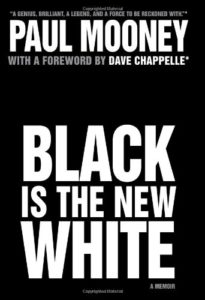Comedian Paul Mooney’s memoir, Black Is the New White has the same familial atmosphere as his stand up routines. Though it chronicles major events in Mooney’s life, it is not an autobiography in the strictest sense. A large portion of it is devoted to documenting a relationship that would change the course of his professional and personal life.
Paul Mooney has never been one to pace back and forth across the stage. He doesn’t speak through a character or a carefully crafted stage persona. He remains stationary, often sitting on a stool and telling jokes. His routines always feel like an evening with a warm yet brutally honest older relative. Black Is the New White finds that groove and settles firmly into it.
All of the bases are covered. We learn of Paul’s childhood in Shreveport, Louisiana and his teenage years in Oakland, California. He talks fondly of the strong women who raised him and how their life lessons, often given in the form of phrases and anecdotes, influenced his worldview and his comedy.
Paul talks about how he served in the military and broke into show business. He offers observations on the overt racism of the old Hollywood system and contrasts it with the institutionalized racism of the current Hollywood. He describes the various ways this phenomenon manifests itself. Mooney uses profane and racially charged humor as a way to vent his frustrations and weed out his true audience. He finds our reactions to his material to be telling.
The inflammatory nature of his and Richard Pryor’s material often lands them both in hot water with censors and executives. Black Is the New White casts them as strangers in a strange land. The aging dinosaurs of old Hollywood try in vain to deny them full access to the dream factory. This point of view is supported by stories that are related with a minimum of sensationalism.
Much of Paul Mooney’s experiences in Hollywood are filtered through his friendship and working relationship with the late great Richard Pryor. Paul’s love for Pryor goes hand in hand with his wariness of Richard’s self destructive tendencies. Mooney understands Pryor’s dark side and tolerates it to an extent. The picture of Richard Pryor that emerges is one of a gifted yet tortured soul. His need for money, drugs and adoration knows no bounds.
Black Is the New White employs an accessible writing style and a format that make it an easy read. Mooney seems to have found a way to make his perspective more palatable without compromising it. On stage, his vocal delivery intimidates less adventurous audience members (as it is intended to). On the page, that barrier no longer exists and the substance of the material can be processed in a different manner. Much like his stand up routine, Mooney’s words are carefully chosen to evoke the desired response. The only thing that has changed is the mode of delivery.
Richard’s presence looms large over Black Is the New White and threatens to swallow it whole at points. Some may come away with the feeling that they learn more about Richard Pryor than Paul Mooney. Even then, it feels slightly truncated. Huge portions of Pryor’s life go unexplored. His relationships with Bill Cosby and Jim Brown for instance. This can be forgiven to an extent as Mooney and Pryor are inextricably linked in the world of comedy.
Black Is the New White offers everything one would expect from Paul Mooney: surprises, revelations, and most of all laughter. It also gives us a portrait of a close friendship and fruitful partnership and proves Mooney to be more than a foul mouthed shock artist. His understanding of his craft is informed by his understanding of race relations. Whether you agree with his observations or not, Paul Mooney’s perspective on the world is endlessly fascinating.
Out of 5
Follow Malice Intended on Twitter @ http://twitter.com/renaissance1977
Follow Us on Twitter @ http://twitter.com/planetill
Join Us on the Planet Ill Facebook Group for more discussion
Check out Planet Ill’s page on Essence.com
Follow us on Networked Blog



One thought on “Book Review: Paul Mooney-Black Is The New White”